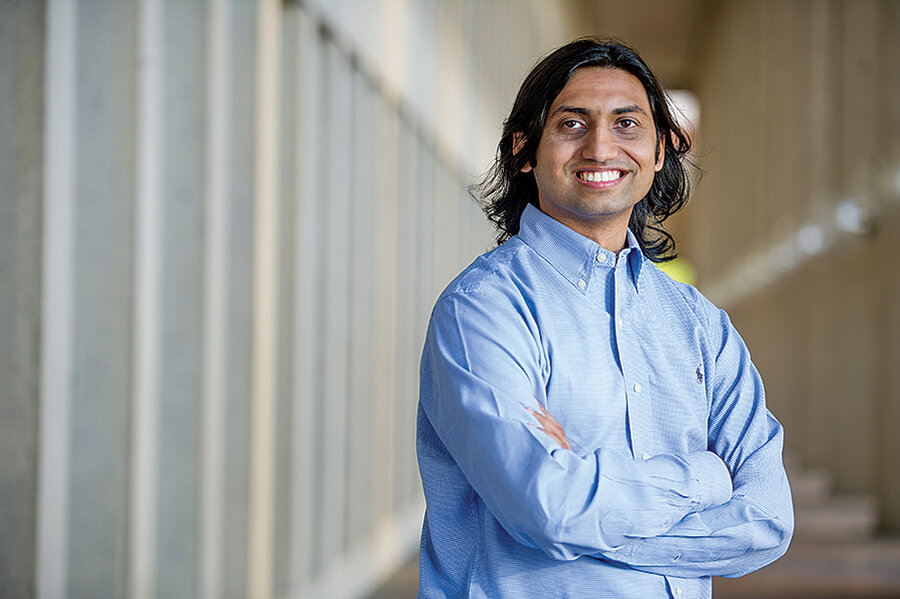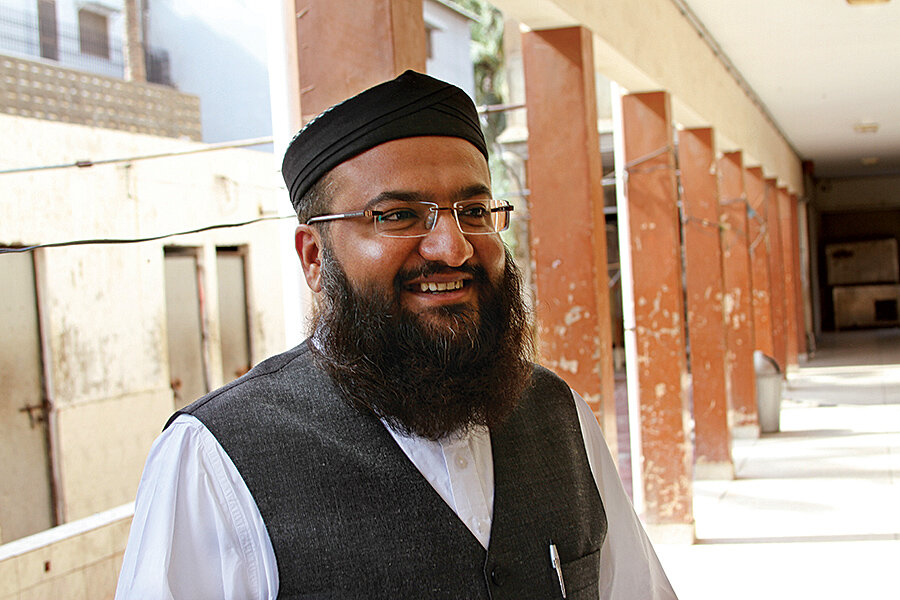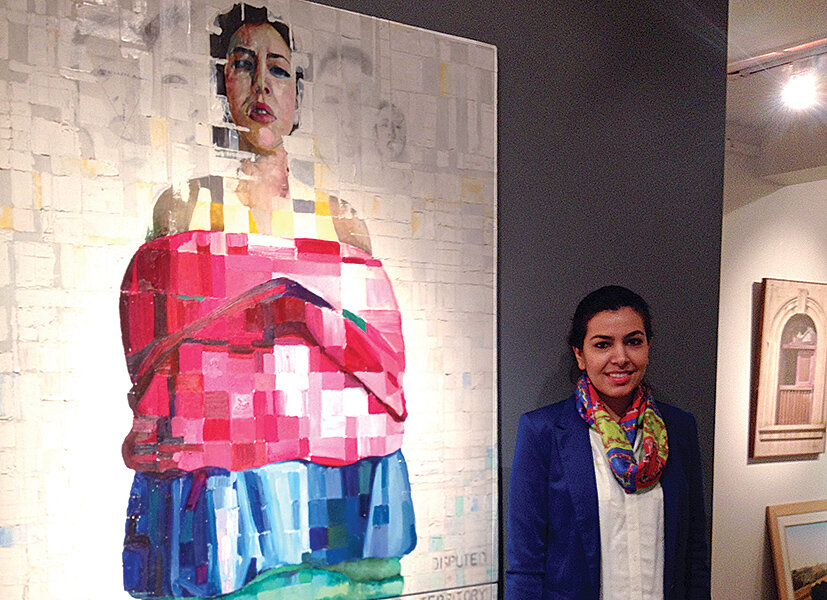Faces of Pakistan's future: From tech entrepreneur to mufti educator
Loading...
| Islamabad, Karachi, and Lahore, Pakistan
Red-brick buildings surround a dusty quad where students play pickup cricket games between classes. Inside a classroom, some of Pakistan’s best students are discussing the nation’s tangled relations with the United States.
Among the few dozen gathered at the liberal arts school of Lahore’s Forman Christian College, opinions vary: Some call the US an “economic hit man” trapping Pakistan with circular debt; others argue Pakistan should not have solicited billions of dollars in aid over six decades.
What unites most of this elite English-speaking group is the expectation that they will eventually hold leadership roles. Several believe they can make a difference. All the women in the room plan on working outside the home.
“Everybody in his or her own capacity can be a catalyst,” says Syed Ali Zia Jaffery, a junior studying international relations and history who blogs against extremism and wants to work in academia or in government.
The students are part of Pakistan’s bulging Millennial generation, the 18-to-36-year-olds who make up a majority of the country. Like Pakistan itself, this rising generation – 60 percent of the population is under 30 – is a diverse group with ethnic, religious, language, and class divides. Some, like Mr. Jaffery, are planning top-level careers. Others struggle for an education. All are faces of the future of Pakistan, the nuclear-armed state of nearly 200 million.
This generation is tired of the global perception that Pakistan is a byword for terrorism, drones, and duplicity. Many are challenging what one Pakistani Millennial calls the “culture of dependency” and want to build a more self-reliant Pakistan.
Yet there is frustration over staggering challenges: a home-grown terrorist insurgency, a slumping economy, a threadbare education system, and a powerful and entrenched political and military establishment.
The US withdrawal from neighboring Afghanistan this year injects further uncertainty. Since 2001, Pakistan has been a key partner in the US-led push against terrorism. Now, there is widespread concern that US money and attention will fade as attention to the region fades.
Pakistan’s rising generation is an area “if not for optimism, at least for some hope,” says Daniel Markey, a Pakistan specialist at the Council on Foreign Relations in Washington and author of the book “No Exit from Pakistan.” “If the country could figure out a way to harness this energy, they could turn it to good.” The danger is that the next generation’s zeal for change often turns to frustration, he warns.
'Millennial' frustrations
Pakistan’s history has never been smooth. The country was founded on a bloody partition from India in 1947 and has since fought two wars with its giant neighbor. Military strongmen have ruled the country for nearly half of its existence. Despite a large English-speaking workforce, the country’s economic potential has rarely met expectations.
Pakistani Millennials share these frustrations: In a survey conducted by the British Council before the election last year, 94 percent of Pakistanis between the ages of 18 and 29 thought the country was heading in the wrong direction. Only 29 percent believed democracy was the best political system for Pakistan, coming in behind military rule and sharia Islamic law.
“Pakistan’s next generation remains on a knife edge,” the report’s authors wrote. “It is far from too late to unleash its potential, but time is beginning to run out.”
One sign of untapped enthusiasm among Pakistan’s youths was the campaign of cricket hero-turned-politician Imran Khan in national elections last year. Thousands of urban middle-class students and young professionals rallied behind Mr. Khan, who ran a campaign based on anticorruption and change that drew comparisons to President Obama’s 2008 campaign.
“Imran Khan is the hero of the young people,” says Aasiya Riaz, codirector of PILDAT (Pakistan Institute of Legislative Development and Transparency), a nonprofit in Islamabad that aims to promote democracy in Pakistan. “Earlier, the youth seemed outside of the political system. They thought politics was too corrupt.”
But instead, two-time Prime Minister Nawaz Sharif was reelected. It was Pakistan’s first successful transfer of power from one democratically elected government to another.
Power in Pakistan is closely held. Pakistan’s leaders have dragged their feet on holding local elections under a constitutional amendment passed two years ago that required provinces to hold them. State and national officials don’t want their traditional role of providing local services – and patronage and power politics – to be undercut, Ms. Riaz says.
“Until we have a fairly well-structured local government system in place where we can engage young people and give them a voice, these youth will become disillusioned,” Riaz says. “It’s sad for any country, because once [young people] go back into their shell it’s hard to get them out.”
The Tech Entrepreneur
Umair Aziz, the young chief technology officer at one of Pakistan’s fastest-growing tech companies, has a problem: After two or three years, the company’s employees tend to leave for Australia, Britain, or the United Arab Emirates.
“They understand their global value,” Mr. Aziz says. “They know they can rise to the top anywhere, and they usually do rise to the top.”
Aziz was once on the same path. After graduating from the College of Wooster in Ohio with a computer science degree in 2000, he moved to Boston to work as a software engineer. But after 9/11 he decided to return home.
He was driven by a personal reason – he wanted to give back to his country – and he spotted a business opportunity. Pakistan had plenty of trained programmers and other skilled professionals who were paid a fraction of the amount paid to similar talent in the US.
Today, Creative Chaos, the company he helped found, is a top-100 Pakistan growth company and is on the Arabia 500 list, a ranking of the region’s fastest-growing companies. It is a regional partner for multinationals such as Coca-Cola and Unilever for software design and digital analytics management. Last year, engineers in his Karachi office built software for 180 police stations in South Carolina.
A walk through the red-and-white cubicles at Creative Chaos finds some of Karachi’s brightest: A recent graduate from Ohio Wesleyan University landed his first job as an associate account manager. A young woman running the Pakistan Unilever social media account says that the company is an extremely popular place to work. Most employees are busily typing at their desks; the ping-pong table and drum set in the basement sit untouched.
For all the excitement Creative Chaos exudes, Aziz is also frustrated that there isn’t a venture capital or angel investor scene in Pakistan for start-ups to raise capital. Foreign clients are scared off by a Pakistan address, so the website promotes its New York City offices.
Government policies, such as a 1-1/2 year ban on YouTube, aren’t business-friendly, Aziz says, despite Mr. Sharif’s pro-business stance. Part of the problem, Aziz says, is that technology systems “allow you to remove corruption from society” by increasing transparency in areas prone to corruption, such as government procurement. “But people don’t want to lose their jobs and their power, so they are resistant.” A 2007 World Bank study concluded that the online procurement of work and goods would help automate services and reduce corruption.
Although Aziz can find enough skilled Pakistanis to work at Creative Chaos, they are the fortunate ones: The majority of Pakistani youths struggle to find a job.
As of last year, only 1 in 10 young Pakistanis between the ages of 18 and 29 held stable employment, according to the British Council survey. Rising prices, unemployment, and poverty are three of the most important issues to this generation, the survey found, above security and terrorism.
“We need 15 years of boring, and then we can be a China or a Malaysia” with economic stability for the next generation, says Azam Chaudhry, a professor at the Lahore School of Economists.
The ‘Madrasa’ Mufti
Madrasas, or religious schools, often are blamed by the West for seeding extremist ideas in young Pakistanis.
But this broad-brush view doesn’t tell the full story.
At the Jamia Islamia Clifton madrasa in Karachi, a school tucked next to a convenience store on a busy street, students are provided free education, food, lodging, clothes, and medical care.
Upstairs, 8-year-old students memorize the Quran. They sit on their knees and sway back and forth over the holy book for four hours, chanting in rhythm as their teachers look on. In classrooms below, students in their 16th year of studies discuss how parents’ wealth should be divided among siblings according to Islamic law.
This madrasa says that it is a moderate school that preaches peace and adds a modern curriculum of English, Urdu, math, computer science, history, and science to its 1,300-year-old religious courses.
“We don’t want our students to just think about Islam. We want them to think about humanity as well,” says Mufti Abu Huraira Mohiuddin, who, with his brother, runs the madrasa that their father started in 1977. “We want the students to understand that we’re providing a nonsectarian education.”
Jamia Islamia’s goals are laudable. It brings together Shiite and Sunni Muslims for gatherings, and it launched a debate competition in which students speak on subjects such as interfaith dialogue. But there are some signs that it may not be as moderate as it preaches. The madrasa’s founder, Mufti Mohammad Mohiuddin, who is removed from day-to-day operations, speaks stridently against Shiite Muslims who he says will start an inter-Muslim war if the US disturbs the balance of power between rivals Iran and Saudi Arabia.
It’s difficult to determine how many children in Pakistan are educated at madrasas, but estimates range from 1 to 7 percent of students, according to a 2010 Brookings Institution report. A greater problem is the overall state of education in the country.
Less than 50 percent of school-age children between 6 and 16 are literate, and 39 percent don’t attend school at all, according to the Asia Society. The government spends less than 2 percent of gross domestic product on education, less than neighboring India and Bangladesh.
Most scholars agree that the link between education and extremism goes beyond madrasa education, says Mr. Markey of the Council on Foreign Relations.
“People started to recognize that the vast majority of education wasn’t happening in madrasas, and many weren’t doing anything other than teaching the Quran, which in and of itself wasn’t turning out terrorists,” he says. “Public schools were often teaching anti-Indian, anti-Semitic [ideas], and were radical in a more nationalist way, which was completely unhelpful.”
The elder Mr. Mohiuddin bristles when he is asked why young Pakistanis might turn to extremism.
“A very small role is played by madrasas,” he says. “Doctors and engineers are also terrorists.”
The Artist
The tension between the many facets of Pakistan is captured on the walls of Gallery 6, founded in 2008 and now Islamabad’s largest private art gallery.
Soft music plays as the curator talks about the pieces hanging on the bright white walls. Some highlight Pakistan’s rural roots, with scenes of lush farmland. Others are avant-garde. There’s a painting made with human hair collected off a hairbrush.
Two paintings by Sana Arjumand, the daughter of the gallery owner, are on display. Since graduating from the National College of Arts in Lahore in 2005, she’s exhibited her work in Pakistan’s biggest cities and abroad.
In a painting called “Here I grew up,” Ms. Arjumand depicts herself under a spotlight. Two exaggerated green figures – one wearing the star and crescent of Pakistan’s flag on her hat – stare at her as they whisper to each other. The painting, nearly seven years old, is from a time when she looked at herself from other people’s perceptions. Now, she’s found inspiration in Sufi teachings, is married with a young child, and is less concerned with what other people think, she says.
But overall, society is still confused about what the identity of Pakistan is, she says. She points to television, on which Indian and Turkish soap operas are plentiful, and to the debate over what clothes are best suited to be Pakistani national dress. “We need to figure out what Pakistan is and what is the Pakistani identity. There’s confusion,” she says. “Everything in Pakistan is now being questioned and changed. We’re going through that point where change is needed.”
The time for Pakistan’s power brokers to listen to the goals and needs of Millennials is now, Markey says. “There’s a very serious risk that this positive energy will not amount to what we might hope, and be squandered,” he says.
Chelsea Sheasley reported from Pakistan on a trip organized by the East-West Center at the University of Hawaii.








